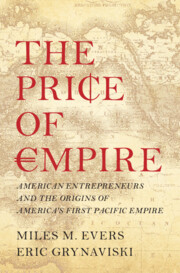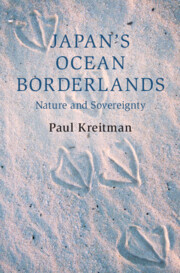44 results
Conclusion
-
- Book:
- The Price of Empire
- Published online:
- 28 March 2024
- Print publication:
- 04 April 2024, pp 151-166
-
- Chapter
- Export citation
2 - Birds and Bases
-
- Book:
- The Price of Empire
- Published online:
- 28 March 2024
- Print publication:
- 04 April 2024, pp 47-71
-
- Chapter
-
- You have access
- HTML
- Export citation
Introduction
-
- Book:
- The Price of Empire
- Published online:
- 28 March 2024
- Print publication:
- 04 April 2024, pp 1-19
-
- Chapter
- Export citation

The Price of Empire
- American Entrepreneurs and the Origins of America's First Pacific Empire
-
- Published online:
- 28 March 2024
- Print publication:
- 04 April 2024
8 - International Trade and Commerce, 1000–1500
- from Section II - The Medieval Economy, 1000–1500
-
-
- Book:
- An Economic History of the Iberian Peninsula, 700–2000
- Published online:
- 22 February 2024
- Print publication:
- 29 February 2024, pp 199-220
-
- Chapter
- Export citation
16 - Trade and the Colonial Economies, 1500–1828
- from Part II - Globalization and Enlightenment, 1500–1800
-
-
- Book:
- An Economic History of the Iberian Peninsula, 700–2000
- Published online:
- 22 February 2024
- Print publication:
- 29 February 2024, pp 409-442
-
- Chapter
- Export citation
Cultivating space for contemporary resistance in Brazil’s Amazon and Cerrado
-
- Journal:
- The Economic and Labour Relations Review / Volume 34 / Issue 4 / December 2023
- Published online by Cambridge University Press:
- 12 January 2024, pp. 825-839
-
- Article
-
- You have access
- Open access
- HTML
- Export citation
15 - Flows of People and Things in Early Modern Japan
- from Part III - Social Practices and Cultures of Early Modern Japan
-
-
- Book:
- The New Cambridge History of Japan
- Published online:
- 15 January 2024
- Print publication:
- 23 November 2023, pp 507-536
-
- Chapter
- Export citation

Japan's Ocean Borderlands
- Nature and Sovereignty
-
- Published online:
- 06 July 2023
- Print publication:
- 27 July 2023
2 - Demand and Consumer Choice
- from Part I - Introduction: Content, Structure, and Strategy of Mainstream Economics
-
- Book:
- The Inexact and Separate Science of Economics
- Published online:
- 25 May 2023
- Print publication:
- 08 June 2023, pp 56-72
-
- Chapter
- Export citation
24 - Global Migrants Foodways
- from Part VII - Migrant Communities, Cultures, and Networks
-
-
- Book:
- The Cambridge History of Global Migrations
- Published online:
- 12 May 2023
- Print publication:
- 01 June 2023, pp 499-518
-
- Chapter
- Export citation
11 - Raw Materials and International Order from the Great War to the Crisis of 1920–21
- from Part II - Institutions
-
-
- Book:
- Peacemaking and International Order after the First World War
- Published online:
- 18 May 2023
- Print publication:
- 01 June 2023, pp 266-286
-
- Chapter
- Export citation
5 - Long-Distance Japanese Trade in the Early Modern Era
- from Part II - Long-Distance Trade
-
-
- Book:
- The Cambridge History of Global Migrations
- Published online:
- 12 May 2023
- Print publication:
- 01 June 2023, pp 108-123
-
- Chapter
- Export citation
24 - From Deforestation to Sustainable Development
- from Part III - Diplomacy
-
- Book:
- Five Times Faster
- Published online:
- 19 March 2023
- Print publication:
- 06 April 2023, pp 261-271
-
- Chapter
- Export citation
Introduction
-
-
- Book:
- Latin American Literature in Transition 1870–1930
- Published online:
- 14 January 2023
- Print publication:
- 08 December 2022, pp 1-12
-
- Chapter
- Export citation
5 - Global Commodities in East African Societies
- from Part II - Interactions
-
- Book:
- On the Frontiers of the Indian Ocean World
- Published online:
- 21 July 2022
- Print publication:
- 04 August 2022, pp 148-169
-
- Chapter
- Export citation
4 - The Classical Period
- from Part I - Diachronic Perspectives
-
-
- Book:
- The Cambridge Companion to the Ancient Greek Economy
- Published online:
- 21 July 2022
- Print publication:
- 04 August 2022, pp 49-60
-
- Chapter
- Export citation
Forecasting commodity returns by exploiting climate model forecasts of the El Niño Southern Oscillation
-
- Journal:
- Environmental Data Science / Volume 1 / 2022
- Published online by Cambridge University Press:
- 13 April 2022, e7
-
- Article
-
- You have access
- Open access
- HTML
- Export citation
Futures of Europe: The City of London’s Commodity Exchanges, the European Economic Community, and the Global Regulation of Futures Trading (1960s–1980s)
-
- Journal:
- Enterprise & Society / Volume 24 / Issue 3 / September 2023
- Published online by Cambridge University Press:
- 11 April 2022, pp. 731-758
- Print publication:
- September 2023
-
- Article
- Export citation
Chapter 8 - “A Story of Chicago”: The Future of Place in Frank Norris’s The Pit
- from Part II - Business Unusual: A New Urban American Literature
-
-
- Book:
- Chicago
- Published online:
- 02 September 2021
- Print publication:
- 23 September 2021, pp 111-124
-
- Chapter
- Export citation



